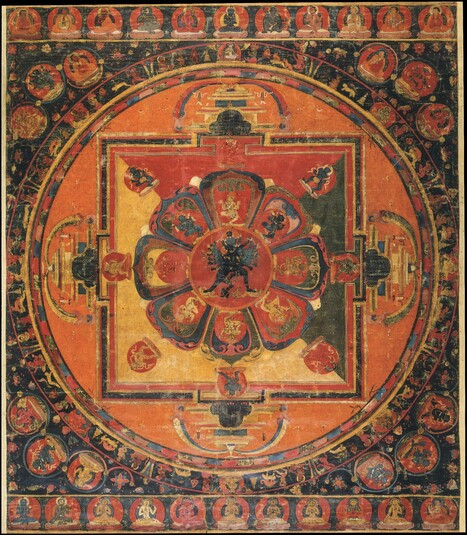
Item: Mandala of Hevajra (Buddhist Deity) - (Samputa Tantra)
| Origin Location | Tibet |
|---|---|
| Date Range | 1300 - 1399 |
| Lineages | Kagyu and Buddhist |
| Material | Ground Mineral Pigment on Cotton |
| Collection | Anna Maria Rossi & Fabio Rossi |
Shastradhara (weapon holding) Hevajra is described in the Samputa Tantra - a shared explanatory Tantra of the Hevajra Root Tantra. Aside from the Samputa Tantra, the most common reference and ritual source for the Shastradhara form of Hevajra is the Vajravali text of Abhayakaragupta.
Sanskrit: Hevajra Tibetan: Gye pa dor je
Tibetan: Gye pa dor je
The principal Tantric practice of Marpa Chokyi Lodro (1012-1096) is said to have been the deity Hevajra and specifically the Shastradhara form. The Shastradhara form was available through other sources of lineage transmission in Tibet and the Himalayas prior to the introduction of the Vajravali text in the 13th century.
There are two main differences between the Hevajra Tantra form of the deity and the Samputa Tantra form of the deity. The first difference is the mandala configuration where the Hevajra Tantra version is called a nine deity mandala and the Samputa version is a seventeen deity mandala. In both cases the Hevajra and Nairatmya figures at the center are counted as one. In the Samputa Tantra, to account for the larger mandala size, eight additional retinue figures are described: four door keepers and four intermediate direction figures. Second, the retinue goddesses in the Hevajra Tantra each have two arms. In the Samputa Tantra the goddesses have four arms each.
See the essential components of a Hevajra mandala with numbered and labeled figures and colour coded sections.
"...Shri Hevajra with a body blue in colour, eight faces, sixteen hands and four legs. The main face is blue, right white, left red, upper face smoky; the two remaining pairs of faces are black. Each face has three eyes and four bared fangs; yellow hair flowing upwards; the top of the head is marked with a vishvavajra. The sixteen hands hold sixteen skullcups. The first right holds a white elephant, the first left holds the yellow God of Earth; these two embrace the Mother. In the second right is a blue horse; third - ass with a white patch; fourth - yellow bull; fifth - ash-coloured camel; sixth - red man; seventh - blue sharabha; eighth - cat with a white patch. In the second left hand is the white God of Water; third - red God of Fire; fourth - green God of Air; fifth - white God of the Moon; sixth - red God of the Sun; seventh - blue Yama; eighth - yellow Holder of Wealth. Each head has a crown of five dry human skulls; and a necklace of fifty fresh heads; six bone ornaments; the two right legs are extended, on the thighs the toes of the two folded left legs are pressing in the half-[vajra] posture in a dancing manner; possessing the nine sentiments of dancing: grace, strength and ugliness; laughter, ferocity and frightful; compassion, fury and peace. In the lap is the mother Vajra Nairatmya, with a body blue in colour, one face, two hands, three eyes; yellow hair flowing upwards; right a curved knife, left holding a skullcup and embracing the father; five dry human skulls as a crown; a necklace of fifty dry [skulls]; five bone ornaments; left leg extended and the right drawn up embracing the father. Both are standing in the middle of a blazing fire of pristine awareness." (Ngagwang Legpa).
"...in the east black Gauri, right hand holding a curved knife, left a rohita fish; south red Chauri, right hand holding a damaru, left a pig; west yellow Vetali, right hand holding a tortoise, left a skullcup; north green Ghashmari, right hand holding a snake, left a skullcup; north-east blue Pukkashi, right hand holding a lion, left an axe; south-east white Shavari, right hand holding a monk, left a monk's staff; south-west purple Chandali, right hand holding a wheel, left a plough; north-west multi-coloured Dombini, right hand holding a vajra, left a wrathful gesture. Also, all have one face, two hands, three eyes and yellow hair flowing upward; naked, adorned with five ornaments of bone; a crown of five human skulls and a necklace of fifty skulls. With the left leg extended and the right in a half-lotus posture, in a dancing manner, they stand in the middle of a blazing fire of pristine awareness." (Konchog Lhundrub).
Jeff Watt 12-2009
Buddhist Deity: Hevajra Mandala (Masterworks)
Mandala: Mandala Main Page
Buddhist Deity: Hevajra Main Page
Collection of Anna Maria Rossi & Fabio Rossi
Mandala: Early Works (1100-1399)
Kagyu: Mandala Masterworks
Buddhist Deity: Hevajra Mandalas
Mandalas: Cemeteries on the Outside
Buddhist Deity: Hevajra, Shastradhara
Subject: Lineage Paintings - Alternating
Painting Set: Vajravali Mandalas (Sadhanamala Registers)

